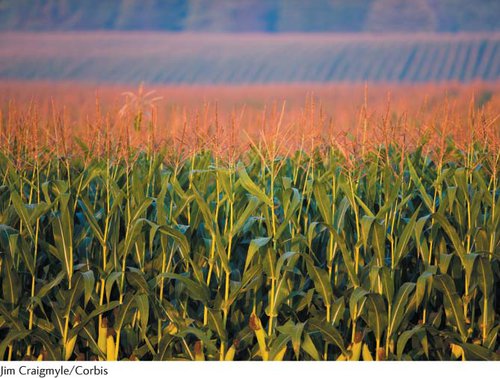Corn Oil and Quantitative Genetics

Methods of quantitative genetics coupled with molecular techniques have been used to identify a gene that determines oil content in corn.
[Jim Craigmyle/Corbis.]
In 2012, the world’s population surpassed 7 billion. The United Nations projects that by 2050 it will increase by another 2 billion. Feeding those additional people will be a major challenge for agriculture in the next few decades. Crop plants will have to provide most of the calories and nutrients required for the world’s future population. Because of dwindling petroleum supplies and concerns about global warming, plants are also increasingly being used as sources of biofuels, placing additional demands on crop production.
To help meet the need for increased crop yields, plant breeders are using the latest genetic techniques in their quest to develop higher-yielding, more efficient crop plants. The power of this approach is demonstrated by research aimed at increasing the oil content of corn. The oil content of corn is an inherited characteristic, but its inheritance is more complex than that of the characteristics that we have studied so far; it is not a simple single-gene characteristic, like seed shape in peas. Numerous genes and environmental factors contribute to the oil content of corn: it results from the interaction of several loci, and their expression is affected by environmental factors.
Can the inheritance of a complex characteristic such as oil content be studied? Is it possible to predict the oil content of a plant on the basis of its breeding? The answers are yes—at least in part—but these questions cannot be addressed with the methods that we used for simple genetic characteristics. Instead, we must use statistical procedures that have been developed for analyzing complex characteristics.
In 2008, geneticists used a combination of quantitative genetic and molecular techniques to identify a gene that plays a key role in controlling the oil content of corn. First, they conducted crosses between high-oil and low-oil corn plants to identify chromosome regions that play an important role in determining oil production. Chromosome regions containing genes that influence a quantitative trait are termed quantitative trait loci (QTLs). Through these crosses, the geneticists located several QTLs that affected oil content; one of them was on corn chromosome 6.
Fine-scale genetic mapping further narrowed the QTL down to a small region of 4.2 centiMorgans on chromosome 6. Researchers sequenced DNA from the region and found that it contained five genes, one of which was DGAT1-2, a gene known to produce an enzyme that catalyzes the final step in a pathway for triacylglycerol biosynthesis. DNA from the DGAT1-2 gene in a high-oil-producing strain of corn contained an insertion of a codon that added phenylalanine to the enzyme, an insertion that was missing from a low-oil-producing strain. The researchers confirmed the effect of the additional phenylalanine codon on oil production by producing transgenic corn that contained the extra codon; these transgenic strains produced more oil than transgenic strains without the extra codon. Interestingly, the extra phenylalanine codon is present in wild relatives of corn, suggesting that the codon was lost in the process of domestication or subsequent breeding of modern varieties.
This research suggests that the oil content of corn and other plants might be increased by genetically modifying their DGAT1-2 genes to contain the extra codon for phenylalanine. Other studies that similarly combine quantitative and molecular analyses have led to the identification of genes that increase the vitamin A content of rice and sugar production in tomatoes.
The genetic analysis of complex characteristics such as the oil content of corn is known as quantitative genetics. We begin this chapter by considering the differences between quantitative and qualitative characteristics and why the expression of some characteristics varies continuously. We’ll see that quantitative characteristics are often influenced by many genes, each of which has a small effect on the phenotype. Next, we’ll examine statistical procedures for describing and analyzing quantitative characteristics. We’ll consider the question of how much of phenotypic variation can be attributed to genetic and environmental influences. Finally, we’ll look at the effects of selection on quantitative characteristics.
